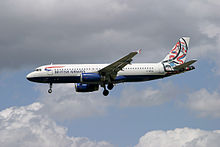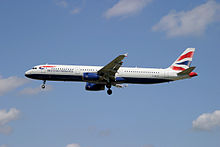|
British Mediterranean Airways
British Mediterranean Airways Limited (BMED), stylised as B|MED, was an airline with operations from London Heathrow Airport in England. It operated scheduled services as a British Airways franchise to 17 destinations in 16 countries throughout Africa, the Middle East, and Central Asia from London Heathrow. In February 2007, the airline was purchased by BMI, and continued as a British Airways franchise until the night of 27 October 2007, when it was absorbed into, and rebranded as, bmi. Before the takeover it was headquartered at the Hetherington House in London Borough of Hounslow, near London Heathrow Airport.[1][2] At an earlier point it was headquartered at the Cirrus House in the Borough of Hounslow,[3][4] near Staines-upon-Thames and Stanwell, Surrey.[3][5] At an earlier point its head office was in the City of Westminster.[6] The company held a United Kingdom Civil Aviation Authority Type A Operating Licence permitting it to carry passengers, cargo and mail on aircraft with 20 or more seats.[7] The licence was revoked on 31 January 2008.[8] History  British Mediterranean Airways was established as a limited company in 1994 by a group of private investors led by Lord Hesketh.[9] It began operations on 28 October that year.[citation needed] The airline operated the Airbus A320 from London Heathrow to Beirut, Lebanon.[9] Damascus in Syria and Amman in Jordan were added to the network the following year, and the airline began flying a fortnightly charter service to Bishkek, capital of Kyrgyzstan.[citation needed] In March 1997 the airline reached an agreement with British Airways, with BA withdrawing its competing services to Beirut, Damascus and Amman, leaving British Mediterranean as the sole operator on a BA franchise basis. Under this agreement the airline traded as British Airways, with all flights operated under BA flight codes (the range BA6500-6669 were allocated to BMED flights). All BMED aircraft were presented in full British Airways livery, appointed with the same interior and class product as the BA main fleet, and staff wore the BA uniform. BMED flights were booked through British Airways and the airline participated in BA's Executive Club and BA Miles programme. BMED was an affiliate member of Oneworld. With the franchise agreement, British Mediterranean's operations moved from Heathrow's Terminal 3 to Terminal 4, allowing greater integration with the BA network. The airline greatly benefited from the franchise arrangement, taking over unprofitable BA mainline services better suited to BMED's lower cost base, to destinations such as Baku, Tehran, Addis Ababa and Almaty. British Mediterranean also launched a number of routes on its own, backed by the global sales and marketing of British Airways, as well as feeder traffic to and from Heathrow. In 2004 BMED carried 277,000 passengers on its 6 aircraft, to 18 destinations in 17 countries. At that time BMED had flights to Tashkent, Uzbekistan. British Mediterranean Airways rebranded as BMED in November 2004, stating that the shorter name and revamped logo would help strengthen the airline's image. On 12 March 2007, it was revealed that the airline was flying a "ghost flight" between London Heathrow and Cardiff International Airport six times a week. No seats were sold for the flight, and it was not announced in arrivals or departures, or on airport information screens. The flight was only made in order for BMED to retain a valuable take-off slot at London Heathrow, unused since it scrapped flights to Uzbekistan. Airlines with landing rights at London Heathrow are liable to lose them if they do not make at least 80% use of their allocation over a six-month session.[10] On 5 April 2007, G-MEDL was used to return 15 British Navy personnel captured by Iranian forces from Tehran to London Heathrow. Impressions Inflight MagazineThe British Mediterranean Airways inflight magazine, titled Impressions, was the first for Ink now one of the world's largest publishers of such periodicals.[11] Sale to BMIFollowing a period of losses, the airline was bought by BMI for £30 million in February 2007.[12] The acquisition marked a change in strategy for BMI by focusing on more medium to long-haul routes. BMED's route network complemented BMI's existing routes. The British Airways franchise ended on 27 October 2007, when the airline was fully absorbed into BMI branding. Aircraft were gradually repainted in the BMI livery, and flights received BMI's flight codes. As part of the acquisition, BMI sold BMED's Heathrow slots to British Airways for £30 million, to be transferred in late 2008. DestinationsBMED served the following on behalf of British Airways, from their hub at London Heathrow Airport:
Incidents and accidents
Fleet The BMED fleet consisted of the following aircraft (at 27 October 2007):
These aircraft were passed on to BMI. See alsoNotes
External linksWikimedia Commons has media related to British Mediterranean Airways.
|
||||||||||||||||||||||||||
